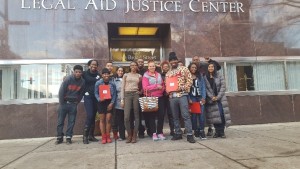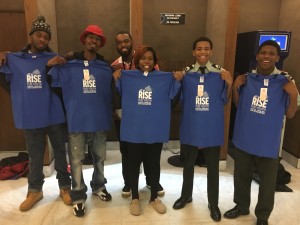In January 2016 the RISE for Youth Coalition[1] facili tated a visioning session as a part of its new Youth for RISE Advisory Network. The Youth for RISE Advisory Network brings together formerly incarcerated youth and those impacted or interested in reforming the juvenile justice system together to discuss how to improve the system for youth and families. Visioning session participants had expertise in what works and what doesn’t work for young people in the juvenile justice system because of their individual and collective experiences.
tated a visioning session as a part of its new Youth for RISE Advisory Network. The Youth for RISE Advisory Network brings together formerly incarcerated youth and those impacted or interested in reforming the juvenile justice system together to discuss how to improve the system for youth and families. Visioning session participants had expertise in what works and what doesn’t work for young people in the juvenile justice system because of their individual and collective experiences.
The participants were tasked with discussing youth crime and appropriate societal responses to it. The discussion was separated into two parts:
1) A mock jaunt through the system, identifying strengths and barriers of current practices along the way from arrest to re-entry and;
2) Identifying the cost of youth incarceration[2], whether the money spent on youth prisons is money well spent, and how it could be spent differently to yield better results. The goal of the second exercise also included identifying what resources could help young people stay “alive and free” in their homes and communities.
The visioning session lasted for just under four hours, and the overarching consensus was that youth prison is not where young people get the help they need. However, the group agreed that in the rare cases where youth incarceration is necessary, it should be for a very short term and should also be safe. They did not believe that there is enough need for youth prisons to justify having them. The following list is what the Youth for RISE Advisory Network identified as ways to best help young people in conflict with the law, instead of spending Virginia’s resources on youth prisons:
- JOBS: Many of the young people identified accessing work as the primary barrier to their success post-incarceration. One young person went to nursing school and has not been able to find a job in nursing because of her conviction. She currently has a lower paying job at a fast food restaurant. Recommendations about jobs include redirecting dollars spent on youth prisons to:
- Subsidize employment for justice-involved young people
- Create access to labor market information for young people
- Help young people and young adults clear their records so that they can get good jobs
- FAMILY SUPPORT: Nearly everyone in the Youth Network noted that their families and families of their peers needed help. Many families are barely surviving. In order to help these families do more than just survive, the Youth Network suggested redirecting money spent on youth prisons to:
- Develop a strong neighborhood-based support system for families in need so that they can better care for their young people at home. Youth prisons divert the resources from the community to facilities and also add an additional stressor to families.
- Create opportunities for families who have children with complex needs to access respite services as a way to keep families together and facilitate reconnection.
- PREVENTION: While the young people engaged in a walkthrough of the system, they noted that more resources needed to be spent on prevention. For example, instead of being arrested, the participants said it would be better to have intensive programs to help young people at risk of breaking the law. Similarly, instead of placing a young person in a prison or other residential placement, the young people advocated for stronger community alternatives.
- COMMUNITY ALTERNATIVES: The community alternatives the young people identified ranged from YMCA and afterschool programs to more intensive services that can help the young person and their whole family. The consensus was that in order for young people and their families to thrive, the community needed to have more vibrant programs for young people. The Youth Network recommended redirecting dollars from youth prisons to communities to build a full spectrum of programs for young people.[3]
- FINES: Many of the young people in the visioning sessions are currently struggling under the heavy weight of fines related to their incarceration that continue to be barriers to their success and re-entry. They suggested that there by an incentive-based fine forgiveness program and also a review of current fines. The Commonwealth could redirect dollars it spends on youth prisons to relieve the burden on young people saddled with fines.
- SMALL BUSINESS LOANS: Not every young person has the interest or skill to attend college. Some young people possess very entrepreneurial spirits and related skills and work ethic. Virginia could redirect dollars spent on youth prisons to provide small business loans to formerly justice-involved young people to become business owners and connect them to comm
 unity in positive ways.
unity in positive ways.
- OPPORTUNITIES TO GIVE BACK: As with small business loans, Virginia could also facilitate give back opportunities so justice-involved young people can be contributors to their communities, not just recipients of services. This could include technical assistance and seed grants to support young people to use their expertise to establish non-profits that can help other young people in need, and their families.
[1] The Re-invest in Supportive Alternatives for Youth Coalition (RISE) is a nonpartisan campaign in support of community alternatives to youth incarceration.
[2] For discussion purposes, the group used $100,000 / year per young person as the cost of incarceration. According to the Department of Juvenile Justice, Virginia spent $142,491 in 2015 to incarcerate a young person for one year. http://www.djj.virginia.gov/pdf/AboutDJJ/DRG/Expenditures_and_Staffing.pdf
[3] The young people were clear that by community-based programs they were referring to non-residential programs designed to keep young people in the community and at home, not in detention centers that some have characterized as “community-based alternatives” to youth incarceration.
